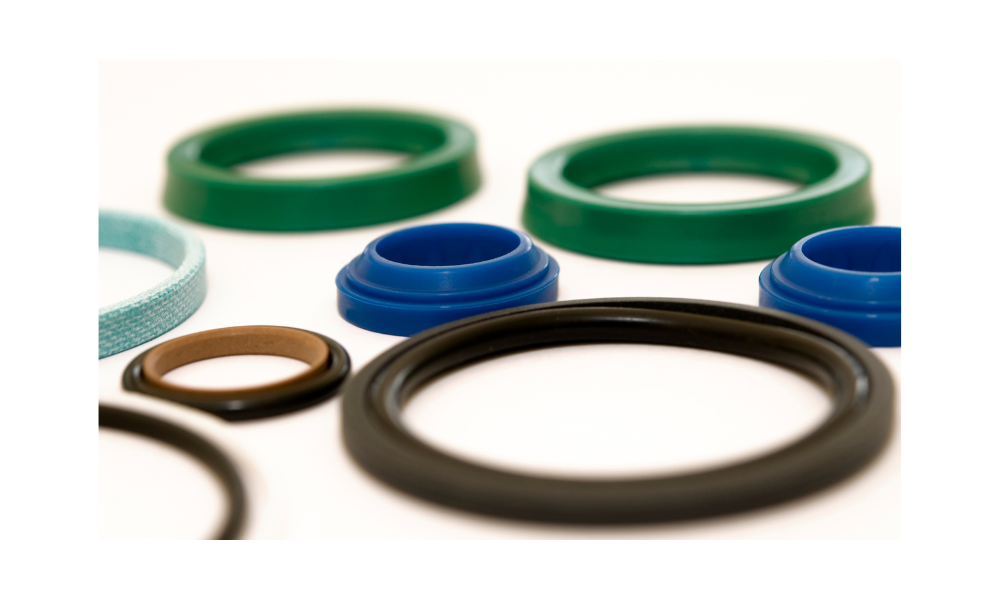Seals play an important role in industrial systems. Different industries and equipment use different types of seals.
Are hydraulic seals and oil seals the same thing? Why are many people confused? Hydraulic seals and oil seals are both used to seal fluid media to prevent leakage. They have different functions in different application scenarios.
Let’s discuss the details of the differences between them.

Table of Contents
ToggleWhat is a hydraulic seal?
Definition: Hydraulic seals are designed to prevent fluid leakage in hydraulic cylinders and other hydraulic systems, acting on seals in both static and dynamic states.
Type: Hydraulic seals types include rod seal, piston seal, wiper seal, Backup ring, guide ring, O-ring, etc.
Material: Hydraulic seals are made of main materials such as PU, PTFE, NBR and FKM, and other rubbers, depending on the application environment.
Working conditions: Acting on reciprocating or linear motion, able to withstand high-pressure environments, such as static seal pressure and dynamic seal pressure. In dynamic seals, some can also withstand high pressure from both directions.

What is an oil seal?
Definition:
Generally speaking, an oil seal refers to a skeleton oil seal, which is also called a shaft seal/lip seal/rotary seal. The skeleton is like the steel bar in the concrete component, which plays a reinforcing role and enables the oil seal to maintain its shape and tension.
Type: Based on structure, oil seals are commonly classified into four categories:
-
W-type (exposed skeleton),
-
Z-type (assembled exposed skeleton),
-
B-type (half-covered skeleton),
-
C-type (fully covered skeleton).
Material: The shell is made of metal, and the sealing ring material is made of PTFE/NBR/FKM.

Differences between Hydraulic Seal and Oil Seal
Structures
The structure of hydraulic seals is relatively simple, generally made of curved elastic materials, and common designs include U-rings, Y-rings, and V-rings. Through this structural design, the sealing ring can withstand pressure from multiple directions in the internal space of the hydraulic cylinder and can effectively prevent hydraulic oil leakage.
Oil seals generally include inner and outer metal skeletons, elastic materials filled between the two, and sealing lips. It has a tight structure, good sealing, and can have a certain self-adjustment ability during axial movement.
Functions
Hydraulic cylinder seals are suitable for dynamic sealing, mainly playing a sealing role to prevent liquid from leaking out of the hydraulic cylinder and impurities from entering the system, while also ensuring the lubrication of the piston rod. Applicable to hydraulic cylinders, hydraulic valves, and other equipment. It is a complete set, and often a set will have several different seals to form a hydraulic seal system. The material selected for each part is also different according to the situation.
Oil seals are generally used for axial static sealing. Its main function is to prevent lubricating oil, hydraulic oil, water, and other substances from entering the equipment from the axial direction or leaking out from the inside. It can withstand a certain lateral force and radial load and can effectively protect equipment parts from foreign matter intrusion and wear. Applicable to various transmission devices, such as engines, transmissions, hydraulic pumps, fans, and other equipment.
Applicable conditions and application areas
The applicable conditions of hydraulic seals are relatively higher, and they can withstand high pressure, high load, high speed, high temperature, and harsh working conditions, but they are generally not suitable for working environments with vibration and repeated pulses.
Hydraulic seals are suitable for hydraulic systems, ships, and other fields, and are suitable for dynamic seals, such as piston rods and valves of hydraulic cylinders.
The applicable conditions of oil seals must be between -40℃ and 100℃, and the working environment must not have strong acid and alkali, oil corrosion, and high-speed rotation.
Oil seals are generally used in mechanical equipment, automobiles, and other fields, and are suitable for fixed axial seals, such as bearings, transmission shafts, etc.
Installation methods
Hydraulic seals are generally installed by press-in installation. Attention should be paid to the alignment and strength during installation to ensure the sealing effect.
Oil seals are usually installed in slots. When installing, pay attention to the installation direction of the skeleton to avoid deformation or damage during installation.
In short, although oil seals and hydraulic cylinder seals are both sealing elements, they have differences in structure, function, and scope of application. You can provide a strong reference for selecting suitable sealing elements for your equipment through an in-depth understanding of them, and improve the service life and stability of the equipment.





